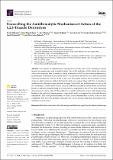| dc.contributor.author | Rabadà, Yvette | |
| dc.contributor.author | Bosch-Sanz, Oriol | |
| dc.contributor.author | Biarnés, Xevi | |
| dc.contributor.author | Pedreño, Javier | |
| dc.contributor.author | Caveda, Luis | |
| dc.contributor.author | Sánchez-García, David | |
| dc.contributor.author | Martorell, Jordi | |
| dc.contributor.author | Balcells, Mercedes | |
| dc.date.accessioned | 2024-07-16T13:57:25Z | |
| dc.date.available | 2024-07-16T13:57:25Z | |
| dc.date.issued | 2024-06-26 | |
| dc.identifier.issn | 1422-0067 | |
| dc.identifier.uri | https://hdl.handle.net/1721.1/155685 | |
| dc.description.abstract | A new family of antifibrinolytic drugs has been recently discovered, combining a triazole moiety, an oxadiazolone, and a terminal amine. Two of the molecules of this family have shown activity that is greater than or similar to that of tranexamic acid (TXA), the current antifibrinolytic gold standard, which has been associated with several side effects and whose use is limited in patients with renal impairment. The aim of this work was to thoroughly examine the mechanism of action of the two ideal candidates of the 1,2,3-triazole family and compare them with TXA, to identify an antifibrinolytic alternative active at lower dosages. Specifically, the antifibrinolytic activity of the two compounds (1 and 5) and TXA was assessed in fibrinolytic isolated systems and in whole blood. Results revealed that despite having an activity pathway comparable to that of TXA, both compounds showed greater activity in blood. These differences could be attributed to a more stable ligand–target binding to the pocket of plasminogen for compounds 1 and 5, as suggested by molecular dynamic simulations. This work presents further evidence of the antifibrinolytic activity of the two best candidates of the 1,2,3-triazole family and paves the way for incorporating these molecules as new antifibrinolytic therapies. | en_US |
| dc.publisher | MDPI AG | en_US |
| dc.relation.isversionof | 10.3390/ijms25137002 | en_US |
| dc.rights | Creative Commons Attribution | en_US |
| dc.rights.uri | https://creativecommons.org/licenses/by/4.0/ | en_US |
| dc.source | Multidisciplinary Digital Publishing Institute | en_US |
| dc.title | Unravelling the Antifibrinolytic Mechanism of Action of the 1,2,3-Triazole Derivatives | en_US |
| dc.type | Article | en_US |
| dc.identifier.citation | Rabadà, Y.; Bosch-Sanz, O.; Biarnés, X.; Pedreño, J.; Caveda, L.; Sánchez-García, D.; Martorell, J.; Balcells, M. Unravelling the Antifibrinolytic Mechanism of Action of the 1,2,3-Triazole Derivatives. Int. J. Mol. Sci. 2024, 25, 7002. | en_US |
| dc.contributor.department | Massachusetts Institute of Technology. Institute for Medical Engineering & Science | |
| dc.relation.journal | International Journal of Molecular Sciences | en_US |
| dc.identifier.mitlicense | PUBLISHER_CC | |
| dc.eprint.version | Final published version | en_US |
| dc.type.uri | http://purl.org/eprint/type/JournalArticle | en_US |
| eprint.status | http://purl.org/eprint/status/PeerReviewed | en_US |
| dc.date.updated | 2024-07-12T12:42:33Z | |
| dspace.date.submission | 2024-07-12T12:42:33Z | |
| mit.journal.volume | 25 | en_US |
| mit.journal.issue | 13 | en_US |
| mit.license | PUBLISHER_CC | |
| mit.metadata.status | Authority Work and Publication Information Needed | en_US |
